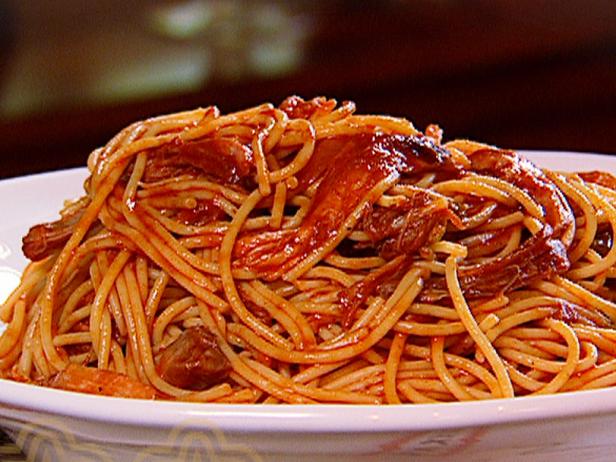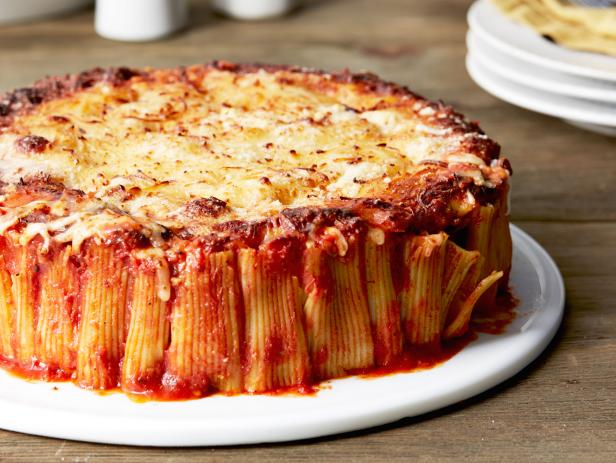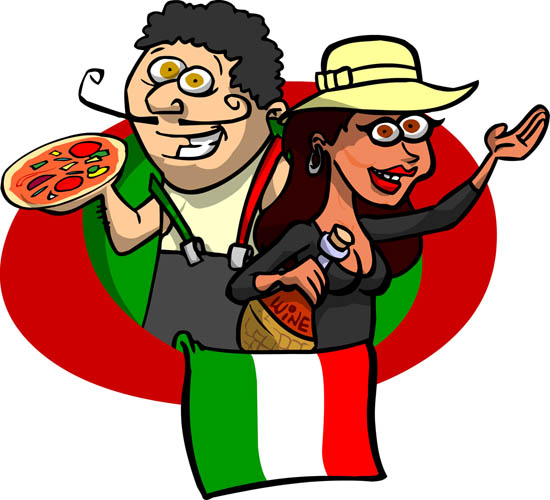Spaghetti
Spaghetti. Sgafetti. Slichetti. Skrenetti. Schlametti.
Spaghetti (Italian pronunciation: [spaˈɡetti]) is a long, thin, solid, cylindrical pasta.[1] Spaghettoni is a thicker form of spaghetti, while capellini is a very thin spaghetti. It is a staple food of traditional Italian cuisine. Like other pasta, spaghetti is made of milled wheat and water and sometimes enriched with vitamins and minerals. Authentic Italian spaghetti is made from durum wheat semolina, but elsewhere it may be made with other kinds of flour.[2] Typically the pasta is white because refined flour is used, but whole wheat flour may be added.
Originally, spaghetti was notably long, but shorter lengths gained in popularity during the latter half of the 20th century and now it is most commonly available in 25–30 cm (10–12 in) lengths. A variety of pasta dishes are based on it, and it is frequently served with tomato sauce or meat or vegetables.
 To learn more click here!
To learn more click here!
Rigatoni
Rigatoni. Rigatoncini. Rig(a)marole. Rigatoni and Mortini. Ragnarok.
Rigatoni [riɡaˈtoːni] are a form of tube-shaped pasta of varying lengths and diameters.[1] They are larger than penne and ziti, and sometimes slightly curved, though nowhere near as curved as elbow macaroni. Rigatoni characteristically have ridges down their length, sometimes spiraling around the tube. And unlike penne, rigatoni's ends are cut square (perpendicular) to the tube walls instead of diagonally.
The word rigatoni comes from the Italian word rigato (rigatone being the augmentative and rigatoni the plural form), which means "ridged" or "lined", and is associated with the cuisine of southern and central Italy.[2][1] Rigatoncini are a smaller version, close to the size of penne. Their name takes on the diminutive suffix -ino (pluralized -ini) denoting their relative size. Rigatoni is a particular favorite pasta shape in the south of Italy, especially in Sicily. Its namesake ridges make better adhesive surfaces for sauces and grated cheese than smooth-sided pasta like ziti.[3]
 To learn more click here!
To learn more click here!
Italian
Italian (About this sound italiano (help·info) [itaˈljaːno] or lingua italiana [ˈliŋɡwa itaˈljaːna]) is a Romance language. By most measures, Italian, together with Sardinian, is the closest to Latin of the Romance languages.[7] Italian is an official language in Italy, Switzerland, San Marino, Vatican City and western Istria (in Slovenia and Croatia). It used to have official status in Albania, Malta and Monaco, where it is still widely spoken, as well as in former Italian East Africa and Italian North Africa regions where it plays a significant role in various sectors. Italian is also spoken by large expatriate communities in the Americas and Australia.[8] It has official minority status in Bosnia and Herzegovina, Croatia, Slovenia and Romania.[9] Many speakers are native bilinguals of both standardized Italian and other regional languages.[10] Italian is a major European language, being one of the official languages of the Organisation for Security and Cooperation in Europe and one of the working languages of the Council of Europe. It is the third most widely spoken first language in the European Union with 65 million native speakers (13% of the EU population) and it is spoken as a second language by 14 million EU citizens (3%).[1] Including Italian speakers in non-EU European countries (such as Switzerland and Albania) and on other continents, the total number of speakers is around 85 million.[3]
Italian is the main working language of the Holy See, serving as the lingua franca (common language) in the Roman Catholic hierarchy as well as the official language of the Sovereign Military Order of Malta. Italian is known as the language of music because of its use in musical terminology and opera. Its influence is also widespread in the arts and in the luxury goods market. Italian has been reported as the fourth or fifth most frequently taught foreign language in the world.[11][12]
Italian was adopted by the state after the Unification of Italy, having previously been a literary language based on Tuscan as spoken mostly by the upper class of Florentine society.[13] Its development was also influenced by other Italian languages and to some minor extent, by the Germanic languages of the post-Roman invaders. The incorporation into Italian of learned, or "bookish" words from its own ancestor language, Latin, is arguably another form of lexical borrowing through the influence of written language and the liturgical language of the Church. Throughout the Middle Ages and into the early modern period, most literate Italian speakers were also literate in Latin; and thus they easily adopted Latin words into their writing—and eventually speech—in Italian. Its vowels are the second-closest to Latin after Sardinian.[14][15] Unlike most other Romance languages, Italian retains Latin's contrast between short and long consonants.[16] As in most Romance languages, stress is distinctive.
 To learn more click here!
To learn more click here!


